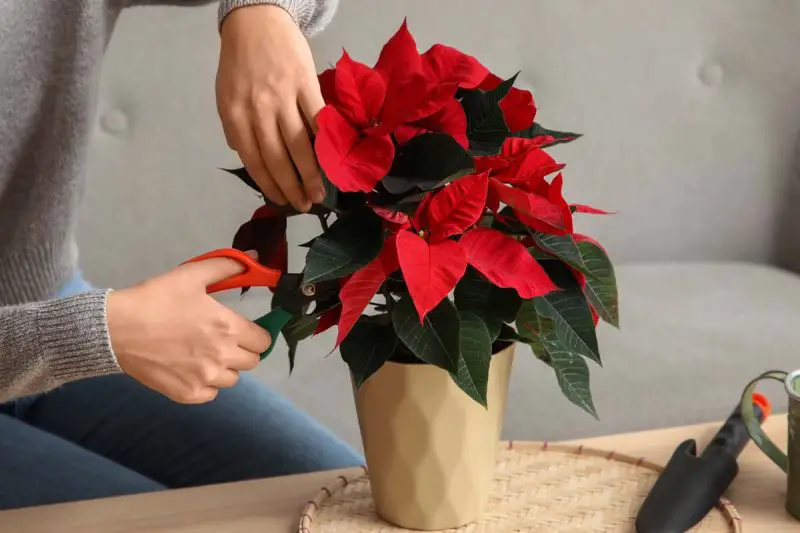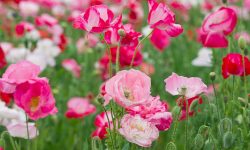The poinsettia is more than just a holiday decoration. With its brilliant red bracts and deep green leaves, it has become a symbol of warmth and festive cheer. Yet, many people discard the plant once the season ends, unaware that proper pruning can extend its life and beauty year after year.
Learning how to prune a poinsettia step by step transforms it from a short-lived decoration into a thriving plant. Pruning encourages stronger growth, richer color, and fuller shapes that return each holiday season. With the right techniques, you can enjoy poinsettias as a lasting centerpiece rather than a fleeting display. This guide will walk you through the essential steps, giving you the confidence to prune successfully and keep your plant vibrant long after the holiday glow fades.
Why Pruning Matters for Poinsettias

Pruning is the key to keeping a poinsettia looking full and vibrant long after the holidays are over. Without pruning, stems become tall, thin, and leggy, causing the plant to lose its compact, bushy form. Over time, unpruned poinsettias may appear sparse and unattractive, reducing the dramatic effect of their colorful bracts. By pruning at the right stages, you encourage balanced growth that supports both healthy foliage and vivid holiday displays.
Another important reason to prune is to manage energy within the plant. When too many stems or leaves compete for nutrients, the poinsettia struggles to maintain its color and vigor. Pruning directs resources toward fewer, stronger stems, resulting in brighter bracts and longer-lasting blooms. It also reduces the risk of overcrowding, which can invite pests and diseases that thrive in dense growth. By keeping airflow open and light evenly distributed, pruning safeguards your poinsettia’s long-term health.
Beyond aesthetics and health, pruning ensures the poinsettia continues its seasonal cycle year after year. Proper trimming stimulates new shoots, setting the stage for buds that develop into holiday bracts. Gardeners who skip this step often find their plants fail to rebloom, leaving them disappointed. Consistent pruning also allows you to shape the plant, maintaining the rounded form most associated with festive displays. By learning how and when to prune, you not only preserve the plant but also create a yearly tradition of beauty. Pruning transforms a temporary decoration into a sustainable source of holiday joy and ensures that your poinsettia thrives far beyond the winter season.
When Is the Best Time to Prune a Poinsettia
Timing is everything when it comes to pruning poinsettias. Pruning too early or too late can stress the plant and interfere with its natural growth cycle. The ideal time for the first major pruning is in spring, usually around late March to early April, once the colorful bracts fade and begin to drop. At this stage, the plant is entering a rest period and can safely be trimmed back without risking damage. Cutting stems down to about four to six inches above the soil helps redirect energy into healthy new shoots.
After the first pruning, the poinsettia focuses on rebuilding strength and producing vigorous new growth. This is a crucial stage, as each cut encourages branching and creates the framework for a fuller plant. A second round of pruning is often needed in midsummer, usually around June or July, to keep the plant compact. This summer trim prevents legginess and ensures the plant develops a rounded, bushy form. During this time, consistent watering and fertilization are important to support the flush of new leaves and stems.
The final pruning stage comes in early fall, around late August to early September, before the plant starts setting buds for the holiday season. Any heavy trimming after this point should be avoided, as it can remove developing buds and reduce bract production. Light pinching may still be done to guide shape, but major cuts should stop. By sticking to this seasonal schedule, you give the plant the best chance to grow strong, balanced, and ready to display its iconic colors. Understanding when to prune is just as important as knowing how, and it makes all the difference in achieving lasting holiday beauty.
Tools You Need for Successful Poinsettia Pruning
Having the right tools makes pruning poinsettias easier, safer, and more effective. A sharp pair of pruning shears is the most essential tool. Dull blades can crush stems instead of making clean cuts, leaving the plant vulnerable to disease. Hand pruners with stainless steel blades are ideal because they resist rust and maintain sharpness longer. For smaller plants, even sharp scissors can work, but professional pruners give better control. Always sanitize your tools before and after use to prevent the spread of bacteria and fungal infections.
Gloves are another must-have item when pruning poinsettias. The milky sap produced by cut stems can irritate the skin and cause mild allergic reactions in some people. Wearing durable gardening gloves not only protects your hands from the sap but also from accidental nicks or scratches. If sap does touch your skin, it’s best to wash the area with soap and water immediately. Having gloves ready ensures that you can prune comfortably without worrying about irritation.
A clean working surface and proper containers for clippings also make the process smoother. Use a small bucket or garden bag to collect cuttings as you work, preventing mess and keeping the area tidy. A disinfectant spray or rubbing alcohol should be nearby to clean tools between cuts, especially if you notice any diseased parts. Some gardeners even keep a small spray bottle of water to mist the plant lightly during pruning, reducing stress on the stems. With the right tools prepared ahead of time, pruning becomes a straightforward task that keeps your poinsettia healthy and beautiful.
Step-by-Step Guide to Pruning a Poinsettia
Preparing the Plant for Pruning
Before making the first cut, it is important to prepare the poinsettia properly. Start by choosing a bright location with good airflow where you can work comfortably. Place the plant on a stable surface, such as a gardening bench or table, so you can access all sides easily. Check that the soil is slightly moist, not dry or soggy, because a hydrated plant responds better to pruning. Dry soil can stress the plant further, while overly wet soil may increase the risk of disease after cutting.
Next, take a few minutes to inspect the overall condition of the poinsettia. Look for weak, yellowing, or damaged stems that will need removal. At the same time, identify the strongest and healthiest stems that should remain as the foundation for future growth. Having gloves and sanitized pruning shears ready ensures that you avoid skin irritation from the milky sap and prevent the spread of pathogens. Careful preparation sets the stage for a smooth and effective pruning process, reducing stress on the plant and increasing your success in shaping it for long-lasting holiday beauty.
Making the First Cuts
When you are ready to prune, begin by cutting back the main stems to about four to six inches above the soil line. This length is ideal because it leaves enough stem for new shoots to emerge while keeping the plant compact. Use sharp, sanitized pruners to make clean, angled cuts just above a leaf node. Angled cuts prevent water from sitting on the wound, reducing the chance of rot. Focus on removing long, leggy stems first, as these tend to grow weak and detract from the plant’s overall shape.
As you cut, remember that each snip encourages branching and fuller growth later. Avoid cutting all stems to the same length, as varying heights will create a natural, rounded look. Remove any dead or diseased branches completely to stop problems from spreading. It’s also helpful to step back occasionally and view the plant from different angles, ensuring a balanced structure. Making thoughtful, deliberate cuts at this stage sets the framework for a healthy, attractive poinsettia that will flourish in the months ahead.
Encouraging New Growth
After the initial cuts, the poinsettia will naturally begin producing new shoots from the nodes left behind. To encourage strong growth, place the plant in a warm, bright location with indirect sunlight. Adequate light fuels photosynthesis and helps the plant recover quickly. Keep the soil consistently moist but never waterlogged, as steady hydration is essential for supporting tender new stems. A balanced, water-soluble fertilizer applied every two to three weeks provides the nutrients needed to fuel healthy leaf and stem development.
Pinching back new shoots is another effective way to stimulate branching. Once stems reach four to six inches in length, gently pinch the tips between your fingers or trim with small pruners. This simple step promotes lateral growth, leading to a fuller, bushier appearance. Over time, repeated pinching creates a strong framework that can support vibrant bracts during the holiday season. By consistently guiding new growth in this way, you transform a spindly poinsettia into a robust and well-shaped plant that remains beautiful year after year.
Shaping the Plant for Holiday Display
As the poinsettia grows through summer and into early fall, shaping becomes an important step to achieve the full, rounded look associated with holiday displays. Begin by observing the overall structure of the plant and identifying areas that appear uneven or overly tall. Trimming back stems selectively helps balance the plant and ensures a uniform shape. It is best to cut just above healthy leaf nodes, encouraging new side shoots that will fill in empty spaces. Regular shaping every few weeks prevents the plant from becoming leggy and prepares it for its vibrant seasonal transformation.
During this stage, gentle pinching can be combined with light pruning to refine the plant’s form. Avoid cutting too aggressively, as removing too much growth at once may shock the plant. Instead, take small steps and allow time for recovery between sessions. Remember that the poinsettia will begin setting buds in early fall, so shaping should be completed before September. A well-shaped plant not only looks more attractive but also supports an even display of colorful bracts. Careful attention to shaping ensures your poinsettia becomes a stunning centerpiece during the holiday season.
Caring for the Plant After Pruning
Once pruning is complete, proper aftercare is essential to help the poinsettia recover and prepare for healthy new growth. The plant has been stressed by cutting, so creating the right environment will determine how quickly it bounces back. Place the poinsettia in a warm room with temperatures between 65 and 75°F, away from drafts or direct heat sources. Bright, indirect sunlight is ideal, as strong direct rays may scorch tender new shoots. Stable conditions during this recovery phase reduce stress and give the plant the best chance to thrive.
Watering habits also play an important role after pruning. The soil should remain consistently moist but never soggy, as excess water can lead to root rot. Allow the top layer of soil to dry slightly before watering again, and always use a pot with good drainage. A balanced fertilizer applied every two to three weeks will provide the nutrients needed to fuel regrowth. Fertilizer high in nitrogen supports leafy development, while phosphorus and potassium strengthen roots and prepare the plant for future blooms.
In the weeks following pruning, continue to monitor the poinsettia for signs of pests or disease, since the open cuts can make the plant more vulnerable. Removing any yellowing leaves promptly helps redirect energy toward strong new growth. With consistent care, the plant will gradually fill out, becoming fuller and more vigorous. Caring for the poinsettia after pruning ensures not only survival but also long-lasting holiday beauty that can be enjoyed year after year.
Seasonal Care and Preparation for the Next Bloom
Spring Care
Spring marks the beginning of the poinsettia’s recovery phase after its winter display. As the colorful bracts fade and fall, the plant enters a period of rest, making this the perfect time to prune back the stems. Cutting them down to about four to six inches allows room for new shoots to develop. During this stage, place the poinsettia in a bright location with indirect sunlight to encourage healthy regrowth without overwhelming the tender stems. Consistent watering is also important, keeping the soil moist but never waterlogged.
Fertilization should begin in spring, using a balanced, water-soluble formula every two to three weeks. This provides the nutrients necessary for rebuilding strength and promoting vigorous growth. Rotate the plant occasionally so all sides receive light evenly, preventing lopsided development. Spring is also the best time to repot if needed, giving the roots more space to expand and refresh the soil with added nutrients. With careful pruning, steady feeding, and attention to light, spring care lays the foundation for a strong, well-shaped poinsettia that will continue to thrive through the year.
Summer Care
Summer is the most active growing season for poinsettias. By this time, the plant should have produced several strong new shoots from the spring pruning. To maintain a compact, bushy shape, pinch back the tips of the stems when they reach about six inches long. This simple practice encourages side branching and prevents the plant from becoming tall and leggy. Place the poinsettia in a bright spot with indirect sunlight, ideally outdoors on a shaded patio or near a sunny window indoors. Warm temperatures and long days provide ideal conditions for steady growth.
Regular watering is essential in summer, as higher temperatures cause soil to dry out faster. Keep the soil consistently moist, but ensure good drainage to avoid root rot. Fertilize every two weeks with a balanced formula to support lush leaf production and overall vigor. If growing the plant outside, bring it indoors before nighttime temperatures drop below 60°F. Summer is also a good time to inspect for pests like whiteflies or spider mites, which thrive in warm conditions. By guiding growth and maintaining steady care, summer prepares the poinsettia for the transition toward its bud-setting stage in the coming months.
Fall Care
Fall is the most critical season for preparing poinsettias to rebloom. As days shorten, the plant naturally shifts toward bud development. To trigger this process, poinsettias need strict light control beginning in late September or early October. Provide at least 14 hours of complete darkness each night by placing the plant in a closet or covering it with a lightproof box. During the day, return it to a bright location with indirect sunlight for at least six hours. This cycle continues for about eight to ten weeks until the bracts begin to show color.
While managing light exposure, maintain consistent care with watering and fertilization. Keep the soil evenly moist but reduce nitrogen-rich fertilizer, as too much nitrogen may encourage leafy growth at the expense of bract formation. Instead, switch to a formula higher in phosphorus and potassium to support strong buds and vibrant colors. Maintain room temperatures between 65 and 70°F, avoiding sudden fluctuations. Fall is also the time to stop any heavy pruning, since cuts during this period may remove developing buds. Careful attention to these details ensures that the poinsettia transitions smoothly from green foliage to its iconic holiday display.
Winter Care
Winter is the season when poinsettias reveal their full beauty. By this stage, the colorful bracts should be fully developed, making the plant the centerpiece of holiday displays. Place the poinsettia in a bright location with plenty of indirect light to maintain its vivid colors. Keep room temperatures steady between 65 and 70°F during the day and slightly cooler at night, but never let it drop below 60°F. Avoid placing the plant near heaters, fireplaces, or drafty windows, as sudden temperature changes can cause leaves and bracts to drop.
Watering during winter requires careful balance. Overwatering can quickly damage roots, while too little water may cause wilting and bract loss. Check the soil often, allowing the top layer to dry slightly before watering again. Since winter is a time of display rather than growth, reduce fertilization, applying a diluted formula only once a month if necessary. Remove any fading leaves or bracts promptly to keep the plant looking fresh. With proper winter care, the poinsettia will remain vibrant throughout the season, setting the stage for a new growth cycle in spring.
Common Mistakes to Avoid and How to Solve Them
Overwatering the Plant
One of the most frequent mistakes in poinsettia care is giving the plant too much water. Because poinsettias are sensitive to soggy soil, constant overwatering leads to root rot and yellowing leaves. Many people water on a fixed schedule without checking the soil first, which often results in excess moisture sitting at the roots. This condition not only weakens the plant but can eventually kill it if left untreated.
The solution is to water based on the soil’s condition rather than the calendar. Always check the top inch of soil with your finger, and only water when it feels dry. Use pots with proper drainage holes to allow excess water to escape, and empty saucers immediately to prevent roots from sitting in water. By following this practice, you maintain balanced moisture that keeps the plant strong and healthy.
Ignoring Light Requirements
Another common mistake is placing poinsettias in areas with poor or inconsistent light. Many people treat them as purely decorative holiday plants and set them in dim corners where they cannot receive enough energy. Without sufficient light, the plant struggles to photosynthesize, leading to weak stems, pale leaves, and reduced bract color. Over time, the poinsettia may become leggy or even lose leaves prematurely, reducing its beauty and vitality.
The solution is to provide poinsettias with bright, indirect sunlight for at least six hours a day. A south- or east-facing window is usually ideal, as it delivers ample light without exposing the plant to harsh midday rays. If natural light is limited, especially in winter, a grow light can help supplement the conditions. Rotating the plant every few days ensures even exposure and prevents it from leaning toward one side. Paying attention to light needs ensures stronger growth and vibrant color during the holiday season.
Pruning at the Wrong Time
Pruning is essential for keeping poinsettias healthy, but doing it at the wrong time can cause serious setbacks. Many people prune too late in the season, often during fall when the plant is setting buds. This mistake removes developing flower structures, leading to fewer or no colorful bracts during the holidays. Others prune too early, before the plant has fully entered dormancy, which can leave it stressed and vulnerable to disease. Timing mistakes often explain why a poinsettia fails to rebloom.
The solution is to follow the plant’s natural growth cycle. Major pruning should take place in spring, after the bracts fade and drop, when the plant is ready to rest. A light summer trim can keep the shape compact, but all heavy cutting must stop by early September. At this point, buds begin forming, and preserving them is key for holiday beauty. By respecting seasonal timing, you ensure each cut encourages growth rather than hinders it, setting the stage for vibrant displays year after year.
Neglecting Post-Pruning Care
A mistake many gardeners make is thinking that pruning alone guarantees success. After cutting, the poinsettia is in a vulnerable state and needs careful support to recover. Without proper aftercare, new shoots may grow weak, leaves can yellow, and the plant may become susceptible to pests or disease. Neglecting essentials like watering balance, fertilization, or temperature control often results in poor regrowth, leaving the plant less attractive for the next holiday season.
The solution is to treat post-pruning care as part of the pruning process itself. Provide the plant with bright but indirect light, consistent moisture, and a balanced fertilizer every two to three weeks. Keep it in a stable environment, away from drafts and heat sources, to minimize stress. Regularly check for pests and remove fading leaves to redirect energy toward new growth. With this attentive care, the plant not only recovers but thrives, rewarding you with fuller foliage and brilliant bracts during its next blooming cycle.
Encouraging Compact and Bushy Growth
One of the main goals when pruning poinsettias is to encourage compact, bushy growth that makes the plant look full and attractive during the holiday season. Without proper care, poinsettias often grow tall and spindly, with bare lower stems that reduce their ornamental value. By pruning and pinching at the right times, you can guide the plant to develop multiple branches, ensuring it maintains a rounded and balanced appearance. This not only improves its shape but also allows the bracts to be displayed more evenly, giving the plant a more festive look.
Pinching is the most effective method for encouraging bushy growth. Gardeners should start pinching about one inch from the tips of new shoots once the plant begins its active growing phase in spring. Repeating this every four to six weeks during the summer stimulates side shoots to develop. Each pinch encourages two or more new stems to grow, which gradually fills out the plant. By the time fall arrives, your poinsettia will have a sturdy framework capable of supporting bright, colorful bracts.
It is important to stop pinching by early September to avoid interfering with the flowering cycle. Poinsettias need short days and longer nights to set buds, and continuing to prune too late in the season may delay blooming or reduce flower production. With careful timing, you’ll strike the right balance between shaping the plant and ensuring a spectacular holiday display. The result will be a poinsettia that is not only healthy and vibrant but also compact and symmetrical, perfect for creating a centerpiece or brightening up any indoor space.
FAQ About How to Prune a Poinsettia
How often should I prune my poinsettia?
Poinsettias should be pruned once a year, typically in late winter or early spring after the colorful bracts have faded. This timing allows the plant to conserve energy before entering its new growth cycle. Throughout the summer, you can pinch back new shoots every few weeks to encourage branching, but stop pruning by early fall to avoid interfering with blooming.
Can I prune poinsettias that I grow outdoors?
Yes, poinsettias grown outdoors also benefit from pruning. In warmer climates, outdoor plants can become tall shrubs if not maintained. Pruning helps keep them compact, encourages bushy growth, and improves flower production. However, timing is crucial—wait until after the blooming season has ended and ensure the risk of frost has passed before cutting back stems.
What should I do with the cuttings from pruning?
The cuttings taken from pruning poinsettias can be used for propagation. Select healthy, non-woody stems and place them in a moist growing medium or water until roots develop. With proper care, these cuttings can grow into new poinsettia plants. This is a great way to expand your collection or share holiday plants with friends and family.
Why does my poinsettia look leggy even after pruning?
If your poinsettia looks leggy, it may not have been pinched back often enough during its growing phase. Regular pinching encourages side shoots and fuller growth. Additionally, inadequate light can cause stems to stretch, so make sure the plant receives plenty of bright, indirect sunlight. A combination of proper pruning and good lighting ensures compact growth.
Is pruning harmful to poinsettias?
Pruning is not harmful when done correctly—it is essential for keeping the plant healthy and beautiful. Removing old or leggy stems allows energy to be redirected toward new growth. Using sharp, clean tools prevents damage and disease. With consistent pruning, your poinsettia will remain vibrant, compact, and ready to produce colorful bracts each holiday season.
Conclusion
Pruning poinsettias is more than just a maintenance task—it’s the key to unlocking their full beauty and ensuring a dazzling holiday display year after year. With careful timing, proper techniques, and thoughtful aftercare, these festive plants transform into compact, bushy, and vibrant centerpieces that brighten any space. By understanding seasonal needs and providing the right conditions, you’ll enjoy poinsettias that not only thrive but also reward your efforts with lasting color and charm. A little attention today guarantees a spectacular burst of holiday cheer tomorrow.






